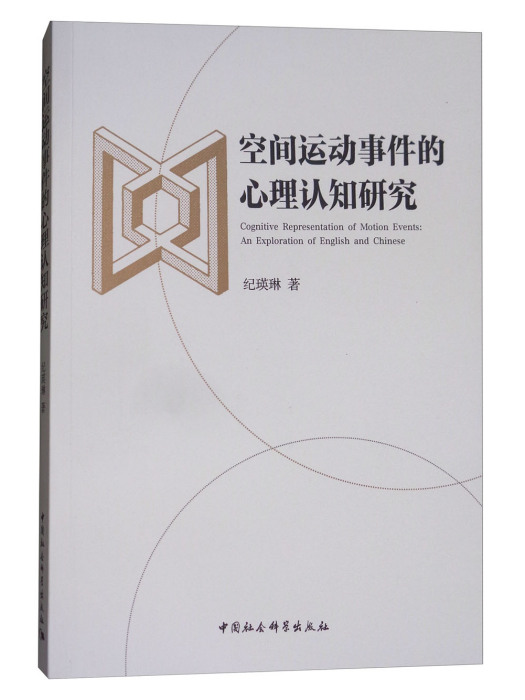《空間運動事件的心理認知研究》是2017年10月中國社會科學出版社出版的圖書,作者是紀瑛琳。
基本介紹
- 中文名:空間運動事件的心理認知研究
- 作者:紀瑛琳
- ISBN:9787516194218
- 頁數:174頁
- 定價:56元
- 出版社:中國社會科學出版社
- 出版時間:2017年10月
- 裝幀:平裝
- 開本:16開

《空間運動事件的心理認知研究》是2017年10月中國社會科學出版社出版的圖書,作者是紀瑛琳。
《空間運動事件的心理認知研究》是2017年10月中國社會科學出版社出版的圖書,作者是紀瑛琳。內容簡介空間領域因其獨特性成為近年來認知語言學研究的一個熱門課題。一方面,人類對空間概念和事件的感知受共同的生物特性影響而具有一...
運動空間知覺是指人腦對運動中客體的大小、形狀、方位、深度等空間特性的反映。主要通過視覺、聽覺、運動覺、膚覺、平衡覺等的聯合活動實現。涉及各種相對靜止的客體及各種運動物體的空間關係。包括客體運動知覺和本體運動知覺。按內容,可分...
空間和運動知覺是兩個基本的視知覺功能。知覺學習可以改善空間和運動知覺功能,但其相關機制尚不清楚。本工作綜合運用心理物理學、動物行為學、在體電生理學等技術方法研究了空間和運動知覺學習的心理物理機制和神經機制,探索了知覺學習的...
本書一章探討了空間運動事件類型學方面的幾個主要問題,澄清了等值框架化語言中多成分動詞的功能,並指出空間表達的類型學研究要聚焦典型化模式來突出關鍵性特徵。本書第二章從兒童一語習得和成人二語習得兩個角度探討在表達運動事件的...
體育運動心理學是研究體育訓練和運動競賽中的心理現象及其規律。它幫助體育運動員了解體育運動技能形成的一般規律及影響因素,掌握克服競爭所帶來的緊張心理與焦慮的調節方法。在當代體育競技水平差距日益縮小的條件下,維持良好的競技心理狀態,...
運動認知主要包括的內容有以下幾方面:知覺方面有空間知覺、時間知覺、速度知覺和錯覺,有分析型與綜合型、精確型與靈活多變的銳利型、對象型與背景型、場獨立型與場依存型等。記憶方面主要有動作的短時記憶與長時記憶、遺忘和回憶。思維...
3.3空間實驗發現:認知神經科學研究(66)3.3.1空間定向(67)3.3.2空間感知與表象(70)3.3.3心理旋轉與目標識別(71)3.3.4質量甄別(73)3.3.5定向自主運動(73)3.4空間實驗發現:人的效能監測(77)3.4.1短期航天飛行中的效能...
體育心理學作為心理學的一個分支,是一門研究人們從事體育活動的專門條件下的心理現象及其發生、發展規律的學科。具體而言,體育心理學是研究體育運動情景中認知、情感和行為的科學。定義 研究體育過程中師生的心理活動和心理品質形成和發展...
(7)運動視差(motion parallax)。頭只要稍微一轉動,物體與視野的關係就變了。這種由於頭和身體的活動所引起的視網膜物像上物體關係的變化,稱為運動視差。當我們運動時,原來靜止的物體看上去也在運動。坐過火車的人有這樣的經驗:在...
第二節 飛行員客體特徵與運動特徵加工 145 第三節 飛行員動態空間表征建構 151 第四節 飛行員動態空間定向 154 第五節 飛行員動態空間定位 157 第六節 飛行員動態空間能力計算優勢及可塑性 161 第八章 動態空間加工的認知滲透性 ...
動物的猛虎跳澗、猴子攀登、飛鳥歸巢,人的上下台階、穿越馬路、工具操作等,無一不是靠空間知覺的判斷。空間知覺是多種感覺器協同活動得到的產物,包括視覺、聽覺、觸覺、運動覺等的活動及相互聯繫,其中視覺系統起主導作用。空間知覺包括...
* 知覺:知覺選擇性,知覺恆常性,圖形知覺,圖形掩蔽,圖形後效(傾斜後效,麥科洛後效,動覺後效),空間知覺(深度知覺-隨機點立體圖,大小知覺),生態光學,運動知覺(似動),時間知覺,言語知覺,可懂度,知覺學習,錯覺,統覺,...
